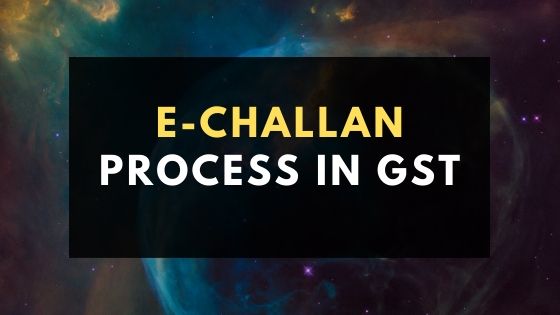Ever since the concept of e-challan in GST has been approved by the GST Council, the discussion around e-challan has gained importance among the business community.
Process of e-challan in GST
The introduction of e-challan by the GST Council in September 2019 was organized with the prime objective of ensuring the inter-operation of e-challan in the GST eco-system. That is why challan is an important document and e-challan is an improvement related to it, it will prove to be very important for businesses to fully understand it and prepare accordingly. So in today’s article, we are going to discuss in detail about e-challan process in GST.
What is e-challan in GST?
- The e-challan process under the Goods and Services Tax system in India, known as electronic invoicing, is a system in which all B2B invoices are uploaded electronically and authenticated by a designated portal.
- After successful authentication on the portal, a unique invoice reference number (IRN) is generated by the IRP for each invoice. With an IRN, each invoice is digitally signed and combined with a QR code. This process is collectively called e-challan under GST.
- In other words, the GST Council approved the standard of e-challan in its 37th GST Council meeting held on 20 September 2019, and accordingly, on 13 December 2019, the government had introduced the legal roadmap for e-challan from notification no. The e-challan has come into force from January 2020 voluntarily. And will also be mandatory for certain categories of people from April 2020.
Why is an e-challan offered?
- Despite the invoices generated through the software, more or less the same type of computer system does not understand it, although business users may fully understand them. For example, an invoice generated by the accounting software “A” cannot be read by a machine using “B” accounting software.
- Today, hundreds of accounting/billing software generating invoices, and all of them have their formats for storing information. Because of this, the GST system cannot read and understand these invoices, although the information in the invoice is the same.
Read Also: Why Spy App is Important to Keep an Eye on Employees
- In the current time, the information of one invoice is presented in different formats. There is no other way that any system can understand this. Therefore, a need was felt to standardize the format in which the electronic data of an invoice would be shared with others to ensure that there was instability in the data
What are the documents to be included in the e-challan system?
The following documents are included under the concept of the e-challan process covered under the Goods and Services Tax system. You can see these documents one by one below. After uploading, the creator of these documents has to upload it to the IRP system.
- Invoice by the supplier.
- Credit note by the supplier.
- Debit note by the supplier.
- Any other document required by law to be reported by the creator of the document.
Note–If you are running an online business then you must know all about GeM Registration for boost business.
How will businesses benefit from electronic invoicing?
Using the e-challan launched by GSTN, the businessmen will get the following benefits: –
- E-challan resolves and plugs a major gap in data cohesion under GST to reduce mismatch errors.
- E-invoices created on software can be read by another, allowing interoperability and helping to reduce data entry errors.
- Real-time tracking of invoices prepared by the supplier is enabled by e-challan.
- Fast availability of real input tax credit.
- There is less possibility of audit/survey by tax authorities as the required information is available at the transaction level.
Which person can upload e-challan?
Under the concept of e-invoice, the seller must electronically upload the invoice to the IRP system and capture the IRN (invoice reference number) in the physical copy of the invoice issued to the recipient. Also, the IRP system is designed to digitally sign e-invoices to the supplier as well as e-mail the recipient with the QR code.
When will the e-challan be introduced?
The e-challan under GST was originally planned to be implemented on 1 April 2020. However, as per the 39th GST Council meeting held on March 14, 2020, the new date for introducing e-challan is October 1, 2020. That is why to ensure that businesses get enough time to adapt to the new system of electronic invoicing. The GST Council has approved the introduction of e-challan in a phased manner. It will be started voluntarily.
- A taxpayer who has a turnover of more than Rs. 500 crores can apply it on the voluntary (trial) basis from January 1, 2020.
- From 1 February 2020, people with a turnover of more than Rs. 100 crore can adopt it (based on voluntary testing).
- The revised date for the mandatory implementation of e-challan is 1 October 2020.
What is the current arrangement for issuing e-challan?
- Currently, businesses generate invoices by various software, and the details of these invoices are manually uploaded to the GSTR-1 return. The challan information is only reflected in the GSTR-2A for recipients to view. On the other hand, the consignor or transporters have to regenerate the e-way bill by manually importing it into Excel or JSON.
- Subsequently, under the new return system, an attachment in the form of the GST ANX-1 form will replace most GSTR-1 returns. However, the process of preparing and uploading the invoice details will remain the same. This will be imported using the Excel tool / JSON or by the online entry of data. E-way bill generation requires a smooth flow of data. E-invoicing will be an important tool to enable this.
Misconception about e-challan under GST.
The biggest misconception about e-challan is in the mind of GST registered person/professional/ consultant, e-challan means to prepare tax challan on the GST portal. Many people think that e-challan will be generated from the tax portal of governments. However, this is incorrect; invoices will continue to be created using accounting or billing software. Under e-challan, the challan is prepared on the ERP software and then a JSON file will be created from the software and will have to be uploaded to the portal.
Read also: How Does Hoobi Global Enhance Privacy for Social Networks?
Another misconception about e-challan is that it applies to all persons who have GST Registration. However, as per the notification, no 910/2019 CT will be applicable on 13 December 2019: –
- For a GST registered person whose total turnover in the financial year is more than Rs 100 crore.
- Concerning the supply of goods or services to a registered person (B2B).

How will e-challan curb tax evasion?
It can help prevent tax evasion in the following ways.
- The tax authorities will have access to the transaction, as they will be generated from the e-challan in real-time, essentially through the GST portal.
- There will be less scope for manipulation of invoices as an invoice is generated before the transaction is performed.
- This will reduce the possibility of fake GST invoices and the only real input tax credit can be claimed as all the invoices need to be generated through the GST portal. Since the input credit can be matched with the output tax statement, it becomes easier for GSTN to track fake tax credit claims.
What are the mandatory areas of the e-challan process in GST?
E-challan should mainly follow GST challan rules. Apart from this, it should also adjust the invoice system or policies after each industry or sector in India. Some information is made mandatory while some of them are optional for business.
Below is a summary of the contents of the e-challan:
- 18 sections (compulsory + optional) consisting of 133 areas in total.
- Out of 18 sections – 8 are compulsory and 10 are optional.
- Within the 8 mandatory clauses, 34 fields are mandatory and 46 are optional. There should be 33 mandatory fields in the e-challan.
- Within the 10 optional sections, 35 fields are optional and 17 are mandatory (if you choose optional sections, these are mandatory fields)
If you want to know more about E-challan under GST for cancelation and more you need to wait for further articles from Articles 4 Business.










